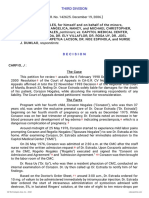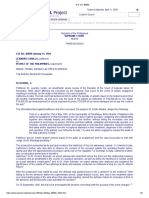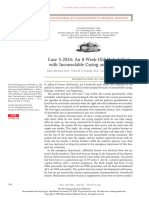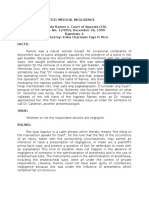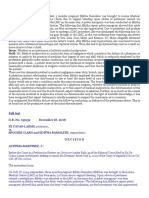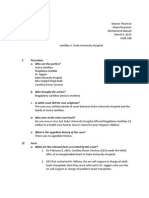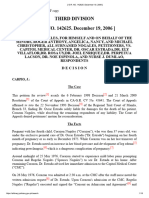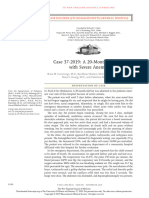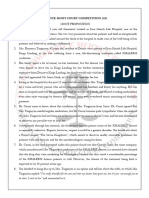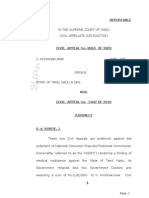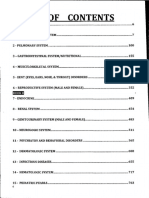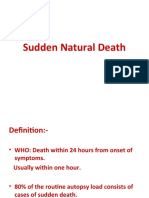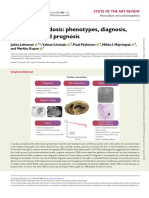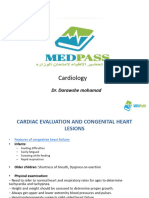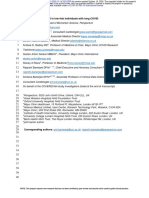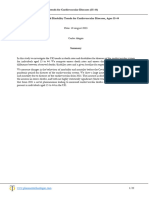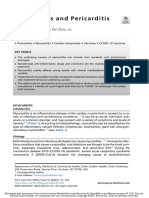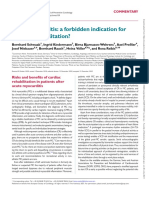CATCHWORDS: Chronic Myocarditis, Adequacy of
CATCHWORDS: Chronic Myocarditis, Adequacy of
Uploaded by
Adam AriwibawaCopyright:
Available Formats
CATCHWORDS: Chronic Myocarditis, Adequacy of
CATCHWORDS: Chronic Myocarditis, Adequacy of
Uploaded by
Adam AriwibawaOriginal Title
Copyright
Available Formats
Share this document
Did you find this document useful?
Is this content inappropriate?
Copyright:
Available Formats
CATCHWORDS: Chronic Myocarditis, Adequacy of
CATCHWORDS: Chronic Myocarditis, Adequacy of
Uploaded by
Adam AriwibawaCopyright:
Available Formats
1
CITATION: Inquest into the death of Kerisha Slim [2011] NTMC 045
TITLE OF COURT: Coroners Court
JURISDICTION: Katherine
FILE NO(s): D0070/2009
DELIVERED ON: 14 October 2011
DELIVERED AT: Darwin
HEARING DATE(s): 27, 28 April 2011
FINDING OF: Mr Greg Cavanagh SM
CATCHWORDS: Chronic Myocarditis, adequacy of
medical treatment, air transfer
procedures
REPRESENTATION:
Counsel Assisting: Ms Elisabeth Armitage
The next of kin: Ms Phillipa Martin
Department of Health
And Families: Ms Jodi Truman
Judgment category classification: B
Judgement ID number: [2011] NTMC 045
Number of paragraphs: 81
Number of pages: 17
2
IN THE CORONERS COURT
AT DARWIN IN THE NORTHERN
TERRITORY OF AUSTRALIA
No. D0070/2009
In the matter of an Inquest into the death of
Kerisha Slim
ON 8 MAY 2009
AT DARWIN
FINDINGS
Mr Greg Cavanagh SM:
Introduction
1. Kerisha Slim (the young girl) was an eight year old Aboriginal girl from
Yarralin community. She died on 8 May 2009 at Royal Darwin Hospital.
She died in severe heart failure as a consequence of chronic Myocarditis,
subsequent to treatment for a facial tumour.
2. Shortly before she died the young girl was released from the Adelaide
Womens and Childrens Hospital for a short period of respite. On the
journey home to Yarralin with her mother, she became ill.
3. She was taken to Katherine District Hospital. Medical staff recognised she
was critically ill and liaised appropriately with specialists at Royal Darwin
Hospital. Although ultimately incorrect, their working diagnosis of sepsis
or septic shock was appropriate given the information available to them
and their observations of the child.
4. When the young girl failed to improve with treatment, timely decisions
were made for her transfer to Royal Darwin Hospital. There was some
delay associated in arranging the practicalities of the transf er but the
evidence did not indicate that this affected her prognosis.
3
5. I find that all times the medical care provided was appropriate and
professional. Ultimately however, the medical care was unable to save this
gravely ill young girl and she died from natural causes.
6. In the inquest Ms Elisabeth Armitage appeared as Counsel Assisting. Ms
Jodi Truman appeared for the Department of Health and Families. Ms
Phillipa Martin appeared for the young girls next of kin. The death was
investigated by Senior Constable Samantha McNeill of the Coronial
Investigation Unit. I received into evidence her report, brief of evidence,
and the young girls extensive medical records. I also received a report
from Dr Didier Palmer, and statements from the young girls fami ly, Ms
Ronda Dashwood and Ms Mary Watson. I heard evidence from Dr Terence
Sinton, Dr Mayda Akhtar, Dr Steven Asher, Dr John Condon, Dr Didier
Palmer, Dr Jeremy Raftos, Mr Keith Burggraaff, and Dr Thomas Revesz.
7. Pursuant to section 34 of the Coroners Act, I am required to make the
following findings:
(1) A coroner investigating
(a) a death shall, if possible, find
(i) the identity of the deceased person;
(ii) the time and place of death;
(iii) the cause of death;
(iv) the particulars needed to register the death under the
Births, Deaths and Marriages Registration Act;
8. Section 34(2) of the Act operates to extend my function as follows:
A coroner may comment on a matter, including public health or
safety or the administration of justice, connected with the death or
disaster being investigated.
4
9. Additionally, I may make recommendations pursuant to section 35(1), (2)
& (3):
(1) A coroner may report to the Attorney-General on a death or
disaster investigated by the coroner.
(2) A coroner may make recommendations to the Attorney-
General on a matter, including public health or safety or the
administration of justice connected with a death or disaster
investigated by the coroner.
(3) A coroner shall report to the Commissioner of Police and
Director of Public Prosecutions appointed under the Director of
Public Prosecutions Act if the coroner believes that a crime may have
been committed in connection with a death or disaster investigated
by the coroner.
Relevant circumstances surrounding the death
Background
10. The young girl was the second child of Ms Rhonda Dashwood and Mr
David Slim. Her brothers and sisters are Amiesha, Kendrick, Shayanne,
David and baby Jaceyline.
11. The young girl was born at Katherine Hospital on 4 August 2000. She was
a healthy baby. She lived in Yarralin with her family. She attended the
clinic for her baby check-ups and weighing. Unfortunately, at the age of
four years the young girl was diagnosed with a very rare form of cancer ,
Sialoblastoma, which is a cancer of the salivary gland and neck.
12. Thereafter followed 18 months of treatment at Adelaide Women's and
Children's Hospital and at Royal Darwin Hospital. The young girl was
supported by her parents and extended family during her hospitalisation.
She underwent two courses of chemotherapy and surgery. By 30 June 2006
her health had improved to the point that she was able to be discharged
back into the community. She returned to Yarralin, remained well and
attended school.
5
13. However, in August 2008, the Sialoblastoma returned. An MRI was
requested by the Yarralin clinic and it was conducted on 22 September
2008 at Royal Darwin Hospital. The results of the MRI confirmed the
return of the tumour. They were received in Yarralin on 13 October 2008.
14. Immediate plans were made for the young girl to return to Royal Darwin
Hospital and then to the Adelaide Women's and Children' s Hospital. She
was re-admitted to Adelaide Women's and Children's Hospital in October
2008. A CT scan conducted on her re-admission showed metastases in
each lung.
15. Given the good responses to chemotherapy achieved in 2005/06 her
treating doctors decided to administer a further course of chemotherapy
over three cycles.
16. The chemotherapy included the drug Epirubicin, which is mildly cardio-
toxic. The young girls course of chemotherapy did not exceed the
recommended dose of Epirubicin for her age or weight al though it is known
that patients tolerance to the drug can vary. Accordingly, as a matter of
precaution and management the young girls cardiac function was
monitored by echocardiograms.
17. Echocardigrams on 28 October 2007 and 16 December 2007 were normal.
On 9 February 2009, after the first cycle of chemotherapy, an
echocardiogram revealed a minor loss of cardiac functioning. This did not
overly concern the treating doctors and the two remaining cycles of
chemotherapy were administered.
18. The chemotherapy was again effective in reducing the size of the tumour to
the point that on 21 April 2009 it was surgically removed. The young girl
appeared to recover well from the surgery.
19. As she had been hospitalised for about seven months, respite from the
hospital environment was considered appropriate.
6
20. On 7 May 2009 the young girl left Adelaide in the care of her mother, Ms
Dashwood. They flew to Darwin and stayed one night at the Christian
Outreach Centre. The young girl appeared reasonably well.
21. On 8 May 2009, they travelled by bus to Katherine. Ms Dashwood noticed
that her daughter was becoming unwell. The young girl was not eating
which made it difficult for her to take her medication. However, as she was
still drinking Ms Dashwood was not seriously concerned.
22. On arrival in Katherine, the young girl was very happy to see her father
and go to her Aunts house. She said that she was hungry but then refused
to eat and instead wanted to sleep. She woke at about 5 pm and vomited.
Ms Dashwood was concerned about her daughter and called an ambulance.
The ambulance attended promptly and Ms Dashwood and the young girl
arrived at Katherine Hospital at 5.45 pm.
23. The young girl was triaged at Katherine Hospital by the nursing staff as a
category 4, a classification which meant she was to be seen by a doctor
within 60 minutes.
24. At 6.53 pm the young girl was seen by Dr Mayda Akhtar. Her chest
examination sounded clear. Dr Akhtar listened to the young girls heart and
noted a regular rhythm. There was no galloping heart rhythm to indicate
possible heart failure. According to Dr Akhtar there was no apparent need
for a chest x-ray, which in any event might have proved impossible to
perform due to the young girls level of non-compliance.
25. Dr Akhtar attempted to examine the young girls abdomen to determine
whether her liver was enlarged. However, as the young girl remained
distressed and uncooperative a thorough abdominal examination was not
possible. Dr Akhtar noted some epigastric tenderness.
26. Dr Akhtar made a provisional diagnosis of vomiting post chemotherapy and
administered IV fluids.
7
27. At 8 pm Dr Akhtar contacted Royal Darwin Hospital and spoke to the
consultant emergency doctor, Dr Steven Asher. In consultation, Dr Asher
made a working diagnosis of infection following immunosuppression from
chemotherapy. Fluids and antibiotics were administered. Thereafter, Dr
Akhtar and Dr Asher maintained regular phone contact.
28. At about 8.40 pm Dr Akhtar attempted to contact the District Medical
Officer (DMO), Dr John Condon. Dr Condon returned the call at 8.50
pm. He was informed of the possible transfer to Royal Darwin Hospital. In
consultation it was considered appropriate to monitor the young girls
response to the current treatment to see if there was an improvement.
29. At 9.30 pm Dr Asher discussed the case with a paediatrician at Royal
Darwin Hospital and Timentin (a further antibiotic) was added to her
treatment regime.
30. By 10.00 pm Dr Asher decided that there had been inadequate response to
the treatment. The working diagnosis was then septic shock. Dr Asher
decided to transfer the young girl to Royal Darwin Hospital. Calls were
made to the DMO so that the transfer could be arranged.
31. Potential wallaby strikes at Tindall Airbase prevented the use of fixed wing
aircraft after dark. Accordingly, the evacuation was to be by helicopter.
32. The DMO located a medically equipped search and rescue helicopter at
Mount Bundy, supporting a military exercise. It took 90 minutes to secure
the necessary approvals and authorisations for use of the helicopter which
was not directly contracted for medical evacuations. At 11.35 pm the
helicopter was secured for the retrieval.
33. At about midnight the helicopter left Mount Bundy for Darwin. It arrived at
12.38 am on 9 May 2009. It was equipped for the medical retrieval,
appropriate medical staff boarded the flight, it was refuelled, and left for
Katherine District Hospital at 1.20 am.
8
34. At 2.57 am the helicopter arrived at Katherine and was refuelled at Tindall
Airbase. The helicopter left Katherine at 5.02 am with the young girl and
arrived at Darwin Airport at 6.16 am. The young girl was then transferred
by ambulance to Royal Darwin Hospital, arriving at 6.43 am.
35. Unfortunately, very shortly after arrival at Royal Darwin Hospital, the
young girl rapidly deteriorated. Resuscitation was commenced. There was
no response to resuscitation and the young girl was declared dead at about
7.40 am.
The autopsy
36. Dr Terence Sinton, Forensic Pathologist, conducted an autopsy on 11 May
2009 and I received his report dated 31 July 2009.
37. Dr Sintons significant findings on autopsy included:
(i) Large volumes of fluid in the chest cavity causing the coll apse of
both lungs,
(ii) An abnormal collection of fluid in the pericardial sac surrounding the
heart, likely to have produced some degree of acute-on-chronic heart
dysfunction (cardiac tamponade),
(iii) Superficial (petechial) haemorrhage to the surface of the heart,
possibly from cardiopulmonary resuscitation (CPR),
(iv) Abnormal fluid accumulation in the abdominal cavity (ascites),
(v) Marked congestion of the liver, indicative of early liver failure,
(vi) Evident acute swelling of the brain (cerebral oedema), and
(vii) Microscopically, evidence of chronic inflammatory damage to the
heart (chronic Myocarditis).
9
38. Dr Sinton considered that the large abnormal collections of fluid were
consistent with the young girl having suffered progressive and very severe
heart failure. The accumulated fluid led in turn to further damage to the
brain, liver and kidneys, and finally death.
39. Dr Sinton noted that Myocarditis is commonly caused by a viral infection
to the heart muscle. It was Dr Sintons opinion that the young girl might
well have suffered such a viral infection as a complication of her recent
chemotherapy.
40. Taking into account the findings at autopsy and the history of the young
girl, Dr Sinton was of the opinion that the young girl died in severe heart
failure as a consequence of chronic Myocarditis, subsequent to
chemotherapy for Sialoblastoma.
41. I agree with Dr Sintons opinion.
Issues arising during the inquest
Did delays associated with the MRI affect the young girls prognosis?
42. As noted above [13], in 2008 the re-emergence of the Sialoblastoma was
confirmed by MRI. There was a delay in securing an MRI appointment and
a 3 week delay between Royal Darwin Hospital obtaining and forwarding
the MRI results to the Yarralin clinic. I am told the res ults were only sent
when the clinic chased them up.
43. I heard evidence from the Clinical Manager of Yarralin Health Centre, Mr
Burggraaff. He told me of the frustrations and delays experienced by
medical staff at remote clinics when dealing with hospitals and specialist
services. Appointments are not promptly made, when made they are not
promptly communicated to the clinic, paper work is lost and results have to
be chased.
10
44. Attempts by the Department of Health in 2010 to improve communications
with enhanced electronic systems (SEMS) have failed to assist clinics such
as Yarralin who are not connected to the electronic network.
45. As to the delays associated with the MRI, I heard evidence from Dr
Revesz, the young girls treating Paediatrician Oncologist and Head of the
Oncology Department at Adelaide Womens and Childrens Hospital. He
told me the young girls cancer, whilst aggressive, was slow growing. It
was his opinion that something in the order of some weeks delay did not
affect her treatment or prognosi s. I accept Dr Reveszs evidence on this
issue.
46. However, I note that this is not the first time I have heard of the
frustrations experienced by remote clinics concerning communications with
hospitals and specialists. Similar concerns were raised last year in the
inquest of Kristelle Ruby Mulladad [2010] NTMC 64. It is to be hoped that
these concerns do not fall on deaf ears and that consultation between the
Department of Health and remote clinics will continue to occur in an effort
to improve the speed and reliability of communications with these primary
health providers.
Did the chemotherapy cause the Myocarditis?
47. On behalf of the young girls family it was submitted that the young girls
chronic Myocarditis was likely to have been caused by the cardio-toxic
drugs administered during chemotherapy.
48. Dr Sinton gave evidence on this issue and he told me:
I do have quite some experience of myocarditis having seen a
reasonable number of cases over the years, and the pattern of disease
seen under a microscope was absolutely characteristic of that seen
with viral infections. And so it's my assumption, based on that
information, that it was more likely than not a viral infection that
produced this damage.(emphasis added)
11
49. Dr Raftos, the Director of the Emergency Department of Adelaide
Womens and Childrens Hospital, also gave evidence on this issue.
Although he thought chemotherapy alone might have been sufficient to
cause the Myocarditis he also told me:
Something happened to the young girl in that trip back on the
buswhich precipitated her sudden deterioration. And an additional
viral infection on top of an already inflamed heart was a
possibilityy.
50. Dr Revesz, the young girls Paediatrician Oncologist was questioned on the
issue and gave the following evidence:
Q. Weve had a couple of differing opinions. Dr Sinton thought
that an infection was the likely cause of the myocarditis in
combination with the effects of chemotherapy. Dr Raftos thought
that the chemotherapy itself may have been sufficient to cause the
inflammation to the heart. What is your opinion as to the most likely
cause of the chronic myocarditis seen by Dr Sinton?
A. Again when I think about the typical cardiotoxicity that
happens a long time after chemotherapy is given, to my mind it was
most likely that it was a combination of factors. And the most
plausible, that it was a combination of chemotherapeutic damage and,
for example, a viral infection.
51. Whilst it is possible that the Myocarditis was caused by the chemotherapy
drugs alone I find it more likely that the young girls chronic heart
condition resulted from a viral infection on a heart and immune system
weakened by chemotherapy.
Was the family informed of the echocardiogram results?
52. It was submitted on behalf of the young girls family that the existence of
heart damage identified in the MRI scan of 9 February 2008 ought to have
been explained to them. In her statement Ms Dashwood said that she did
not know that the young girls echocardiogram results were abnormal.
53. In evidence Dr Revesz frankly told me:
12
One of the deficiencies that weve identified as a consequence of
the mortality review is that we don't have a perfect system or a very
satisfactory system for the echocardiograms to find their way into
the case notes if it wasn' t there in the case notes it wouldnt
have prompted me or one of my colleagues to discuss it with
mother.
He also frankly told me:
Weve always had a meeting with parents at the beginning and also
at recurrence. That involves one of the nursesthe social worker
and a consultant. Now, admittedly, we are not very good at
documenting it and this is something that has started to happen since
last year. ... It would be good and they are making efforts now to do
that a lot more. But we do discuss it, theres absolutely no question
about it.
54. On the evidence it appears possible that the echocardiogram results were
not discussed with the family. Certainly no discussions were documented.
However, it must be remembered the damage identified was minor. The
young girls treating doctors were satisfied the chemotherapy should
continue and, later, that the young girl was well enough for respite. The
acute worsening of her condition was entirely unexpected. In the
circumstances I consider that any discussions would not have alerted the
family to the risk of heart failure or affected the decisions that were made.
55. However, when something goes wrong it will often be important to
accurately know what was discussed with patients and their families when
decisions about care and treatment are being made. Accordingly, I support
the efforts of the Oncology Department towards improving their
documentation in this regard.
Should there have been a further echocardiogram before respite?
56. The results of the 9 February 2009 echocardiogram were documented as a
normal L ventricular size with borderline ventricular function (fractional
shortening: 24%). The septum and anterospetal region appeared mildly
hypokinetic. Otherwise normal cardiac function.
13
57. Dr Sinton considered that such a finding indicated early, mild damage to
the heart. Dr Sinton was of the opinion that if another echocardiogram had
been conducted in April or May further deterioration of heart function
might have been detected.
58. Dr Revesz considered the 9 February 2009 results amounted to a borderline
alteration and told me that the young girls heart function was still within
the accepted norm.
59. After her chemotherapy and surgery, the young girl looked well and there
were no clinical observations indicative of any further heart deterioration.
There was nothing about her observations which might have prompted a
further echocardiogram.
60. Whilst it is possible a further echocardiogram might have detected
additional heart damage, the fact that there was not a further
echocardiogram does not, in my view, indicate any want or failing in the
young girls care. In this regard I give weight to the following comments of
Dr Revesz:
The difficulty is that this is an extremely rare situation. The
cardiotoxicity that we normally see happens much much later. The
typical situation would be someone like this young girl (exposed to)
potentially cardiotoxic agents, would lead a perfectly normal life and
have acute heart failure in later life ... Its very very difficult to
predict who are the people who are going to develop those problems
and who are the ones that despite a marginal shortening of their ..
ventricular function, they actually go through life without any issue.
And thats why its sometimes difficult to know what we do to cover
our butts, to be crude.
61. All adverse outcomes result in a mortality review by the Oncology
Department at the Adelaide Womens and Childrens Hospital. In this case
the review recommended that:
14
All patients currently receiving potentially cardiotoxic
chemotherapy regularly undergo cardiac evaluation at the start of
treatment and at regular intervals during and after chemotherapy.
Ongoing research in supportive care may bring new insights into
cardiotoxicity which in turn could lead to better, more selective
chemotherapeutic agents and / or better protection from these
effects.
62. I support those recommendations.
Was the working diagnosis and treatment at Katherine District Hospital
appropriate?
63. Dr Akhtar made an initial provisional diagnosis of vomiting post
chemotherapy. Whilst ultimately incorrect, the provisional diagnosis was
reasonable, given the patient history and observations that Dr Akhtar was
able to obtain.
64. The provisional diagnosis changed to one of infection following
consultation with Dr Asher at 8 pm. Later when her condition did not
improve the diagnosis progressed to septic shock. Whilst the diagnoses
were ultimately incorrect, given the information available to the doctors Dr
Raftos (a senior doctor in charge of the Emergency Department at Adelaide
Womens and Childrens Hospital) was of the opinion, which I accept, that
the diagnosis of septic shock was:
a very reasonable diagnosis. In fact the most likely diagnosis that
someone would come to in a child receiving chemotherapy who was
unwell. And they followed the care plan and appropriate steps that
one would do to septic shock, which was antibiotics, which a range
of antibiotics were given that I think are appropriate. Fluid for
dealing with what appeared to be shock and was indeed shock.
Was the young girl correctly triaged?
65. Triage categories are determined in accordance with the Australian Triage
Scale. There are five levels of acuity:
Category 1: Immediately life-threatening
Category 2: Imminently life-threatening
15
Category 3: Potentially life-threatening or important time-critical
treatment or severe pain
Category 4: Potentially life serious or situational urgency or
significant complexity
Category 5: Less urgent
66. Dr Palmer, Director Top End Retrieval Service, told me the young girl
ought to have been initially triaged as a category 3 and not as a category 4.
A correct categorisation would have called for the young girl to be seen by
a doctor within 30 minutes as opposed to within 60 minutes for a category
4. He also said that a delay of 30 minutes in all the circumstances of this
case was not significant and did not affect the care, treatment or prognosis
of the young girl.
67. Dr Raftos gave similar evidence to Dr Palmer on this point.
68. While a triage category of 3 was warranted upon admission to Katherine
District Hospital, I find that the category 4 that was given did not affect the
outcome for the young girl.
Was there undue delay in the young girls evacuation?
69. There were no night-time, fixed wing, flights out of Tindall Airbase
because of a real threat of collision with wallabies on the runway. Transfer
by ambulance was not an option as there was insufficient medical staff at
Katherine to provide appropriate medical support in an ambulance. The
only possibility for night time evacuation was by helicopter.
70. As at 8 May 2009 there was no formal system of air transfer by helicopter
in place. The system was under review and in the meantime the process
was described to me as ad hoc. The evidence demonstrates that on the night
of the young girls transfer approximately two and a half hours additional
delay can be attributed to the ad hoc nature of the arrangements.
16
71. However, Dr Palmer told me the ad hoc arrangements had been replaced
with interim arrangements resulting in a reduction in readiness-for-
departure times. Under the interim arrangements helicopters are usually
ready to depart in about thirty minutes. As at the date of inquest, the
interim arrangements included the availability of a specified fully
medically configured helicopter.
72. I was further informed that tendering for a fully integrated service, to be
run by the Top End Retrieval Service, was underway. Once implemented
the service was designed to result in faster transfers. Details of the
integrated service were contained within Dr Palmers tendered report.
73. Of course in any service, physical assets such as helicopters, and human
assets such as trained medical staff, are finite. If dedicated helicopters or
aircraft are already in use, they might be unavailable or delayed if required
to attend later emergencies. The best service will not always ensure an
immediate response. But I am assured by Dr Palmer that the new service is
far, far more likely to be mission capable at any point in time.
74. In the circumstances of this case, I find there was additional delay in the
young girls retrieval because of the ad hoc arrangements that were
operating.
75. However, on all the evidence before me I find that this young girl was
gravely ill. She had recurrent cancer and secondary tumours. She was
suffering from an undetected chronic and severe heart condition which was
very difficult to diagnose. Neither Dr Pal mer nor Dr Raftos were of the
view that a delay of two hours was significant in respect of the young girls
prognosis. Accordingly, I am unable to find that the delay in her retrieval
contributed to her death.
76. As at the time of the inquest, the retrieval service was under complete
overhaul in preparation for a fully integrated service. Even the ad hoc
17
service in operation as at 8 May 2008 had been replaced by the improved
interim arrangements. Any comments I might have made about the ad hoc
service would now be otiose, and therefore I make no comment or
recommendation about them.
Findings
77. The young girl died in Royal Darwin Hospital on 9 May 2008 from chronic
Myocarditis subsequent to chemotherapy for Sialoblastoma. She died of
natural causes.
78. Although her condition was not correctly identified at Katherine District
Hospital, the treating doctors working diagnoses were suitable to the
presenting symptoms and available information. Thereafter, her care was
appropriate and decisions were made with proper levels of consultation and
within acceptable time frames.
79. Although there were some delays throughout her treatment and in
particular in her evacuation to Royal Darwin Hospital, I am unable on all
the evidence to find that these contributed to her death.
80. I make no recommendations arising from this inquest.
Formal Findings
81. Pursuant to section 34 of the Coroners Act (the Act), I find, as a result
of evidence adduced at the public inquest, as follows:
(i) The identity of the Deceased person was Kerisha Slim
born on 4 August 2000 at Katherine. The Deceased resided at
Yarralin, in the Northern Territory of Australia.
(ii) The time and place of death was 7.40 am on 9 May 2009 at
Darwin.
18
(iii) The cause of death was chronic Myocarditis subsequent to
chemotherapy for Sialoblastoma. .
(iv) Particulars required to register the death:
1. The Deceased was Kerish Slim.
2. The Deceased was of Aboriginal descent.
3. The Deceased a school student.
4. The cause of death was reported to the coroner.
5. The cause of death was confirmed by post mortem
examination carried out by Dr Sinton.
6. The Deceaseds parents are Ms Rhonda Dashwood and
Mr David Slim.
Dated this 14
t h
day of October 2011. _________________________
GREG CAVANAGH
TERRITORY CORONER
You might also like
- 1000 Peer Reviewed Studies Questioning Covid-19 Vaccine SafetyDocument3 pages1000 Peer Reviewed Studies Questioning Covid-19 Vaccine SafetyHansley Templeton Cook100% (1)
- Legal Medicine Compiled CasesDocument194 pagesLegal Medicine Compiled CasesKarmaranthNo ratings yet
- Amicus BriefDocument27 pagesAmicus BriefThe FederalistNo ratings yet
- Allarey vs. Dela Cruz, G.R. No. 250919, November 10, 2021Document24 pagesAllarey vs. Dela Cruz, G.R. No. 250919, November 10, 2021Aprilyn CelestialNo ratings yet
- Carillo V PeopleDocument10 pagesCarillo V PeopleLorenz L. Llamas IIINo ratings yet
- Carillo vs. PeopleDocument9 pagesCarillo vs. PeopleKevin AmpuanNo ratings yet
- Petitioners Vs Vs Respondents: Third DivisionDocument17 pagesPetitioners Vs Vs Respondents: Third DivisionBret MonsantoNo ratings yet
- Television, Bedpans, and Me: A Life Lived in the Red Centre of AustraliaFrom EverandTelevision, Bedpans, and Me: A Life Lived in the Red Centre of AustraliaNo ratings yet
- Legmed A (For PDF Reading)Document324 pagesLegmed A (For PDF Reading)Sofia BrondialNo ratings yet
- Severe MalariaDocument52 pagesSevere MalariaEnoch OseiNo ratings yet
- Carillo V PPLDocument9 pagesCarillo V PPLParis LisonNo ratings yet
- Balane, Tamase, Alampay Law Office For Petitioner. The Solicitor General For The PeopleDocument6 pagesBalane, Tamase, Alampay Law Office For Petitioner. The Solicitor General For The PeoplevivivioletteNo ratings yet
- Legal MedicineDocument258 pagesLegal MedicineMark Christian B. Apordo100% (3)
- Custom Search: Today Is Thursday, April 12, 2018Document14 pagesCustom Search: Today Is Thursday, April 12, 2018Hazel Marie EchavezNo ratings yet
- Legal MedicineDocument34 pagesLegal MedicinepasmoNo ratings yet
- Carillo Vs PP 229SCRA386Document9 pagesCarillo Vs PP 229SCRA386robdeqNo ratings yet
- Care StudyDocument44 pagesCare StudyTheophilus BaidooNo ratings yet
- Casumpang v. CortejoDocument18 pagesCasumpang v. CortejoSai RosalesNo ratings yet
- Carillo Vs PeopleDocument9 pagesCarillo Vs PeopleCali AustriaNo ratings yet
- G.R. No. 171127Document20 pagesG.R. No. 171127nineballwhiteglintNo ratings yet
- Petitioners vs. vs. Respondent: Second DivisionDocument25 pagesPetitioners vs. vs. Respondent: Second DivisionAleah LS KimNo ratings yet
- 2015 Casumpang - v. - Cortejo20231004 11 1jk3ewnDocument25 pages2015 Casumpang - v. - Cortejo20231004 11 1jk3ewnkaloy915No ratings yet
- Case Presentation - Severe AnemiaDocument141 pagesCase Presentation - Severe Anemiajenl87% (23)
- Nejm CASODocument9 pagesNejm CASOJuan Esteban Rincon HuertasNo ratings yet
- 185 F.3d 141 (3rd Cir. 1999) : United States Court of Appeals For The Third CircuitDocument18 pages185 F.3d 141 (3rd Cir. 1999) : United States Court of Appeals For The Third CircuitScribd Government DocsNo ratings yet
- Digest ObliconDocument57 pagesDigest ObliconEarl Justine OcuamanNo ratings yet
- Cayao-Lasam vs. RamoleteDocument9 pagesCayao-Lasam vs. RamoleteWilfredNo ratings yet
- HCM 388 - Group Case 2Document5 pagesHCM 388 - Group Case 2api-284614437No ratings yet
- NogalesDocument19 pagesNogalesJashen TangunanNo ratings yet
- Dr. Noel Casumpang vs. Cortejo G.R. No. 171127, March 11, 2015Document29 pagesDr. Noel Casumpang vs. Cortejo G.R. No. 171127, March 11, 2015FD BalitaNo ratings yet
- Art.2177 Lourdes Hospital Vs CapanzanaDocument18 pagesArt.2177 Lourdes Hospital Vs Capanzanamaria lourdes lopenaNo ratings yet
- Choice Words A Collection of Writing About Abortion (Louise Swinn)Document287 pagesChoice Words A Collection of Writing About Abortion (Louise Swinn)Frankle BrunnoNo ratings yet
- Nogales Vs Capitol Medical CenterDocument19 pagesNogales Vs Capitol Medical Centersarguss14No ratings yet
- (10) Nograles vs CMC G.R. No. 142625Document13 pages(10) Nograles vs CMC G.R. No. 142625Shamir John AbejarNo ratings yet
- BOOK GPBJ Sunaina 050821 PDFDocument26 pagesBOOK GPBJ Sunaina 050821 PDFLou LotusNo ratings yet
- 1st and 2nd WeekDocument218 pages1st and 2nd WeekRamos GabeNo ratings yet
- Nejmcpc 1904048Document10 pagesNejmcpc 1904048luca.win92No ratings yet
- No. 15 Casumpang-v-CortejoDocument2 pagesNo. 15 Casumpang-v-CortejoGretchen Dominguez100% (1)
- Health Law Important QuestionsDocument9 pagesHealth Law Important Questionsmvilan21No ratings yet
- Novice Moot Court Competition 2021: Be Alive. I Want To Live" and Consented To ItDocument3 pagesNovice Moot Court Competition 2021: Be Alive. I Want To Live" and Consented To Itmisao1No ratings yet
- Medical Malpractice COMPLETEDocument9 pagesMedical Malpractice COMPLETEAlexis Von TeNo ratings yet
- Our Lady of Lourdes V CapanzanaDocument18 pagesOur Lady of Lourdes V CapanzanaSteph RubiNo ratings yet
- V Krishna Kumar Medical NegligenceDocument25 pagesV Krishna Kumar Medical NegligenceKranthi ChirumamillaNo ratings yet
- Carillo v. PeopleDocument2 pagesCarillo v. PeopleAmber AncaNo ratings yet
- Rogelio P. Nogales Vs Capitol Medical CenterDocument9 pagesRogelio P. Nogales Vs Capitol Medical CenterJumen Gamaru TamayoNo ratings yet
- GR No. 142625 Rogelio Nogales V Capitol Medical CenterDocument21 pagesGR No. 142625 Rogelio Nogales V Capitol Medical CenterRuel ReyesNo ratings yet
- Case # 1 Our Lady of Lourdes Hospital, Petitioner Spouses Romeo and Regina Capanzana, RespondentsDocument2 pagesCase # 1 Our Lady of Lourdes Hospital, Petitioner Spouses Romeo and Regina Capanzana, RespondentsjohnricNo ratings yet
- Care StudyDocument19 pagesCare StudyPaschal AngnasooriNo ratings yet
- Nej M CPC 1900596Document9 pagesNej M CPC 1900596Oscar TorresNo ratings yet
- A Case Report of Wilms TumorDocument3 pagesA Case Report of Wilms TumorAna LyanaNo ratings yet
- G.R. No. 171127Document23 pagesG.R. No. 171127Lorenz L. Llamas IIINo ratings yet
- Super Final ManuDocument44 pagesSuper Final Manujanedump2001No ratings yet
- Children's Hospital & Research Dec. 20, 2013 Opposition To Temp. Restraining Order.Document6 pagesChildren's Hospital & Research Dec. 20, 2013 Opposition To Temp. Restraining Order.Betsy A. RossNo ratings yet
- DIGESTDocument12 pagesDIGESTTrisha Paola TanganNo ratings yet
- Summary of J. Paul Waymack's Well, Doc, It Seemed Like a Good Idea At The Time!From EverandSummary of J. Paul Waymack's Well, Doc, It Seemed Like a Good Idea At The Time!No ratings yet
- 47 - Cruz Vs Court of AppealsDocument2 pages47 - Cruz Vs Court of AppealsJoannah GamboaNo ratings yet
- 83 Casumpang V Cortejo, GR No. 171127, March 11, 2015Document17 pages83 Casumpang V Cortejo, GR No. 171127, March 11, 2015Andrei Da JoseNo ratings yet
- Myocardial Infarction RevisedDocument57 pagesMyocardial Infarction RevisedAlexandra Nicole Magday GragasinNo ratings yet
- Case Scenario - Week 4 - Group 2Document34 pagesCase Scenario - Week 4 - Group 2Angel Hannah100% (1)
- The Use of Levosimendan in Children With Cancer With Severe Acute Cardiac Dysfunction Case Series and A Review of The LiteratureDocument4 pagesThe Use of Levosimendan in Children With Cancer With Severe Acute Cardiac Dysfunction Case Series and A Review of The Literaturehadi40canadaNo ratings yet
- Pir December 2023Document62 pagesPir December 2023ceciliagandulfoNo ratings yet
- Japan: 2 mRNA Jabs Ordered To Add Myocarditis To ADR List: Label RevisionDocument4 pagesJapan: 2 mRNA Jabs Ordered To Add Myocarditis To ADR List: Label RevisionlelloNo ratings yet
- MiokarditisDocument30 pagesMiokarditismaulana wasis0% (1)
- PPP v3Document771 pagesPPP v3Steven Lam100% (1)
- PP PresentationDocument21 pagesPP Presentationalfiya al-azainNo ratings yet
- Kardiomiopati JurnalDocument8 pagesKardiomiopati Jurnalnetizen baikNo ratings yet
- BMM 2018 0348Document14 pagesBMM 2018 0348Harpreet SinghNo ratings yet
- 11.sudden Natural Death 3Document55 pages11.sudden Natural Death 3Hasabo AwadNo ratings yet
- Myocarditis Pediatrics-1Document5 pagesMyocarditis Pediatrics-1AMOS MELINo ratings yet
- Cardiac Sarcoidosis EHJ Review 2023Document16 pagesCardiac Sarcoidosis EHJ Review 2023AnaNo ratings yet
- CardiologyDocument43 pagesCardiologyhasanatiya41No ratings yet
- Multi-Organ Impairment in Low-Risk Individuals With Long COVIDDocument23 pagesMulti-Organ Impairment in Low-Risk Individuals With Long COVIDAnonymous GF8PPILW5No ratings yet
- Report V-Damage Analysis - Cardiovascular 15-44 - V3Document22 pagesReport V-Damage Analysis - Cardiovascular 15-44 - V3Zerohedge Janitor100% (1)
- Pathomorphology MCQSDocument191 pagesPathomorphology MCQSNana BentilNo ratings yet
- Myocardial Diseases: Marvi G. Dulnuan - Niog, MD, FPSPDocument94 pagesMyocardial Diseases: Marvi G. Dulnuan - Niog, MD, FPSPLianne LagayanNo ratings yet
- Myocarditisandpericarditis: Philip Hunter Spotts,, Fan ZhouDocument14 pagesMyocarditisandpericarditis: Philip Hunter Spotts,, Fan Zhoumiltoncaballero5No ratings yet
- C A Nine Chagas' Disease (American TR Ypa Nosomia Sis) in Nor TH Americ ADocument10 pagesC A Nine Chagas' Disease (American TR Ypa Nosomia Sis) in Nor TH Americ AjesusNo ratings yet
- A Systematic Review of The Systematic Review of Post COVID-19 SyndromeDocument6 pagesA Systematic Review of The Systematic Review of Post COVID-19 Syndromeeditorial.boardNo ratings yet
- PericarditisDocument120 pagesPericarditisCalin Popa100% (1)
- 1 s2.0 S2666084921008056 MainDocument6 pages1 s2.0 S2666084921008056 Mainnina purnamasariNo ratings yet
- Myocarditis and ExerciseDocument5 pagesMyocarditis and ExercisePhitsanu SuntornpiyapanNo ratings yet
- Endokarditis, Miokarditis Perikarditis: Blok KardiovaskularDocument31 pagesEndokarditis, Miokarditis Perikarditis: Blok KardiovaskularTiara RamliNo ratings yet
- Guidelines For Prescribing Clozapine in SchizophreniaDocument30 pagesGuidelines For Prescribing Clozapine in Schizophreniakabulkabulovich5No ratings yet
- NCLEX Practice Exam 21 (60 Questions)Document36 pagesNCLEX Practice Exam 21 (60 Questions)Melodia Turqueza GandezaNo ratings yet
- The Quest For New Approaches in Myocarditis and in Ammatory CardiomyopathyDocument18 pagesThe Quest For New Approaches in Myocarditis and in Ammatory Cardiomyopathyrohman cooyNo ratings yet
- PREP ICU 2013 Answers and Critiques - 2 - Mar & AprDocument39 pagesPREP ICU 2013 Answers and Critiques - 2 - Mar & AprNicholasHuffNo ratings yet






